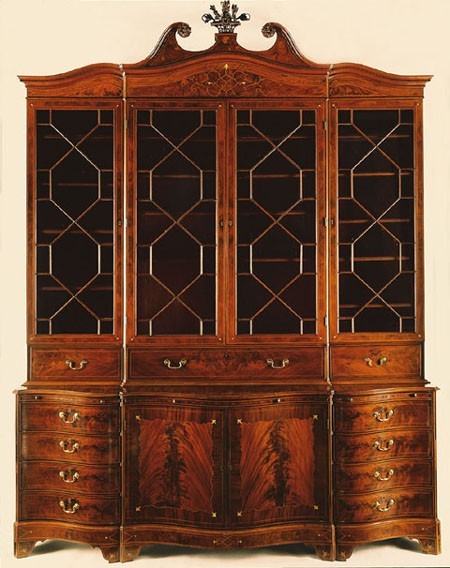
Library bookcase attributed to Martin Pfeninger, Charleston, South Carolina, 1770–1775. Mahogany, mahogany and burl walnut veneer, and ivory and unidentified wood inlays with cypress. H. 128 3/4", W. 99", D. 20 1/2". (Courtesy, Charleston Museum; photo, Gavin Ashworth.)
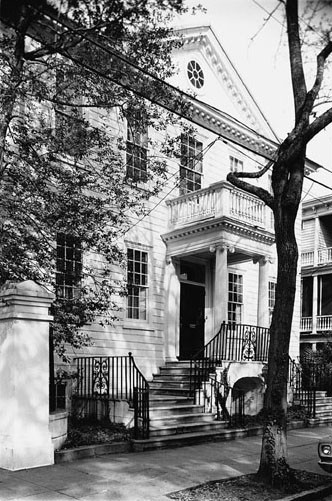
John Edwards House, 15 Meeting Street, Charleston, South Carolina, completed about 1770. (Photo, William Struhs.) This structure is the only surviving eighteenth-century Charleston frame house with a rusticated facade.

The Holmes-Edwards library bookcase as illustrated in Esther Singleton, The Furniture of Our Forefathers (New York: Doubleday, Page and Company, 1901), p. 150. This image indicates that the basket ornament was partially restored by the early twentieth century.
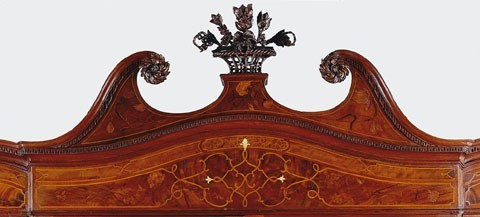
Detail of the pediment of the library bookcase illustrated in fig. 1. (Photo, Gavin Ashworth.) The five straight sprigs with leaves and flowers behind the rose of the basket-and-flower ornament are incorrect replacements.
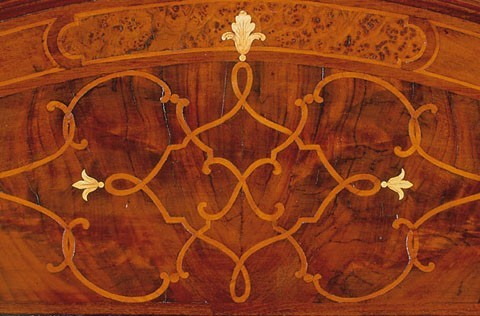
Detail of the scrollwork, mahogany and burl veneer panels, and engraved ivory husks on the frieze of the library bookcase illustrated in fig. 1. (Photo, Gavin Ashworth.)

Detail of the floral marquetry on the frieze and tympanum of the library bookcase illustrated in fig. 1. (Photo, Gavin Ashworth.) The color contrasts of the marquetry were originally stronger.
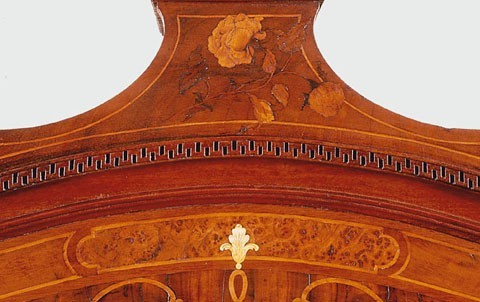
Detail of the floral marquetry on the tympanum plinth of the library bookcase illustrated in fig. 1. (Photo, Gavin Ashworth.)
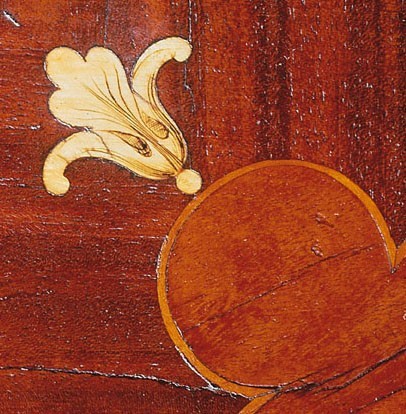
Detail of an engraved ivory husk on a lower door of the library bookcase illustrated in fig. 1. (Photo, Gavin Ashworth.)

Detail of the dustboard construction on the library bookcase illustrated in fig. 1. (Photo, Gavin Ashworth.)
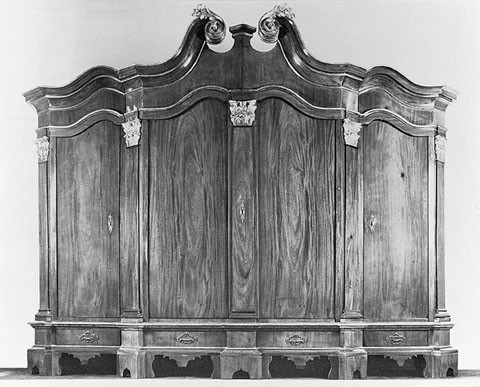
Dielenschrank, Lubeck, Germany, 1760–1770. Woods not recorded. H. 95 5/8", W. 122 13/16", D. 32 1/4". (Illustrated in Wolfgang Schwarze, Antike Deutsche Mobel: das Burgerliche und Rustikale Mobel in Deutschland von 1700–1840 [Wuppertal, Germany: by the author, 1977], p. 16, fig. 17.)

Standuhr, Brunswick, Germany, ca. 1770. Woods not recorded. H. 88 1/2". (Illustrated in Wolfgang Schwarze, Antike Deutsche Mobel: das Burgerliche und Rustikale Mobel in Deutschland von 1700–1840 [Wuppertal, Germany: by the author, 1977], p. 70, fig. 177.)
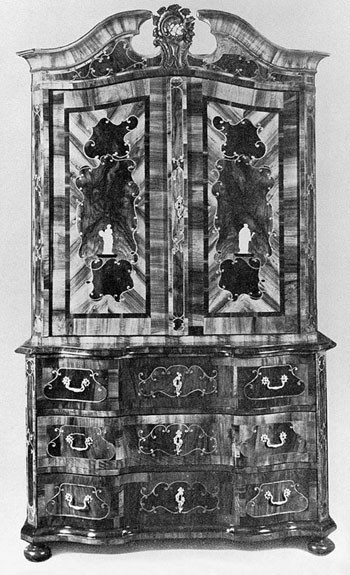
Kommodenaufsatzschrank, Brunswick, Germany, 1750–1760. Woods and dimensions not recorded. (Illustrated in Wolfgang Schwarze, Antike Deutsche Mobel: das Burgerliche und Rustikale Mobel in Deutschland von 1700–1840 [Wuppertal, Germany: by the author, 1977], p. 64, fig. 156.)
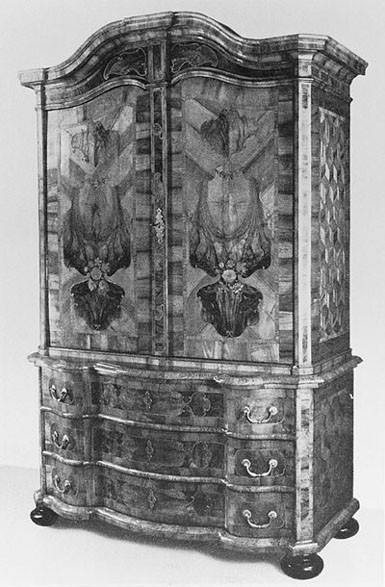
Kommodenaufsatzschrank, Brunswick, Germany, ca. 1750. Woods not recorded. H. 100", W. 58 1/4", D. 29 1/2". (Illustrated in Wolfgang Schwarze, Antike Deutsche Mobel: das Burgerliche und Rustikale Mobel in Deutschland von 1700–1840 [Wuppertal, Germany: by the author, 1977], p. 70, fig. 176b.)

Chest of drawers with inlay attributed to Martin Pfeninger, Charleston, South Carolina, 1775–1782. Mahogany, mahogany veneer, ebonized beech and unidentified lightwood inlays with yellow pine and mahogany. H. 34", W. 41 1/2", D. 24 1/4". (Courtesy, Colonial Williamsburg Foundation.)
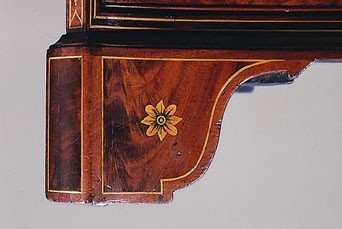
Detail of a bracket foot on the chest of drawers illustrated in fig. 14.

Detail of two bracket feet on the library bookcase illustrated in fig. 1, showing inlays and stringing. (Photo, Gavin Ashworth.)
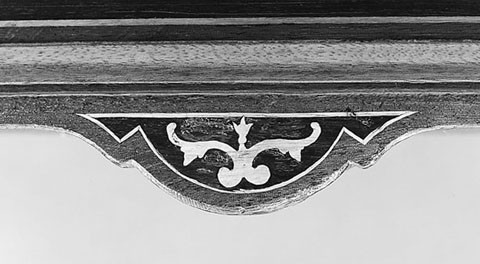
Detail of the base pendant on the chest of drawers illustrated in fig. 14.
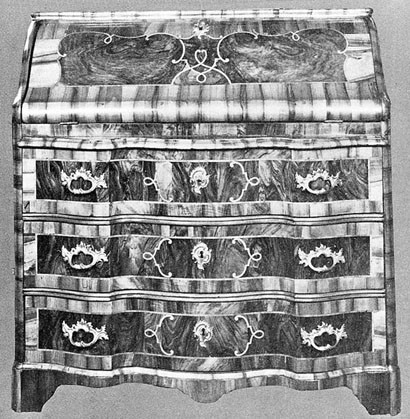
Schreibkommode, Brunswick, Germany, 1750–1760. Woods not recorded. H. 45 1/4", W. 43 5/16", D. 24 13/16". (Illustrated in Wolfgang Schwarze, Antike Deutsche Mobel: das Burgerliche und Rustikale Mobel in Deutschland von 1700–1840 [Wuppertal, Germany: by the author, 1977], p. 64, fig. 154.)

Kommodenschrank, Brunswick, Germany, 1750. Woods not recorded. H. 96 1/2", W. 57", D. 29 1/2". (Illustrated in Wolfgang Schwarze, Antike Deutsche Mobel: das Burgerliche und Rustikale Mobel in Deutschland von 1700–1840 [Wuppertal, Germany: by the author, 1977], p. 63, fig. 153.)
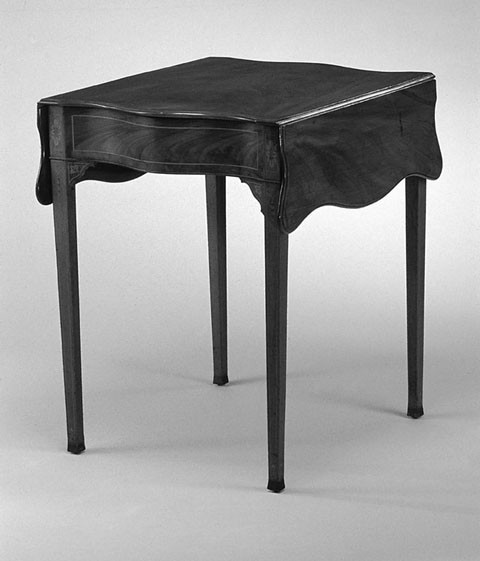
Breakfast table with inlay attributed to Martin Pfeninger, Charleston, South Carolina, 1775–1782. Mahogany, mahogany veneer, and unidentified lightwood inlays with cypress and ash. H. 28 7/8", W. 21 1/2" (closed), D. 243/4". (Private collection; photo, Museum of Early Southern Decorative Arts.)

Detail of the leg and bracket inlay on the breakfast table illustrated in fig. 20.
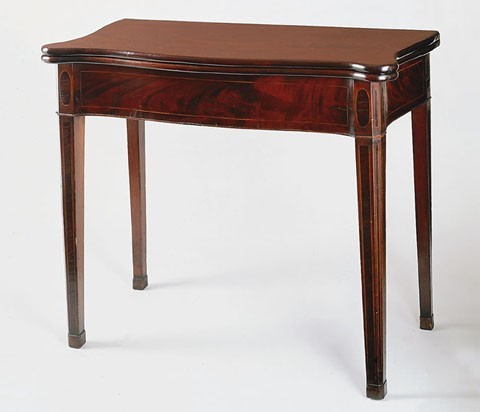
Card table, Charleston, South Carolina, 1775–1785. Mahogany, mahogany veneer, and unidentified lightwood inlay with cypress and mahogany. H. 29 3/8", W. 36", D. 17 13/16" (closed). (Courtesy, Charleston Museum; photo, Gavin Ashworth.)
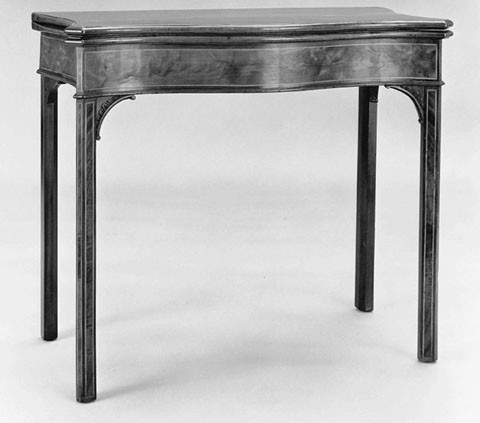
Card table, Charleston, South Carolina, 1770–1785. H. 29 3/8", W. 34 1/2", D. 17 1/2" (closed). (Collection of the Museum of Early Southern Decorative Arts.)
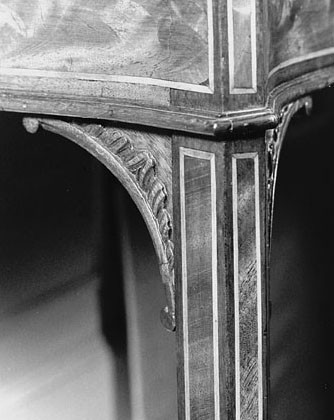
Detail of a carved bracket on the card table illustrated in fig. 23.

Detail of the swing-leg/rail joint of the card table illustrated in fig. 22. (Photo, Gavin Ashworth.)
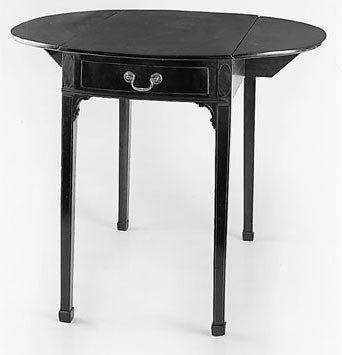
Breakfast table, Charleston, South Carolina, 1775–1785. Mahogany, mahogany veneer, and unidentified lightwood stringing with cedrela, tulip poplar, and white pine. H. 28 1/2", W. 36 1/8" (open), D. 30". (Private collection; photo, Gavin Ashworth.)
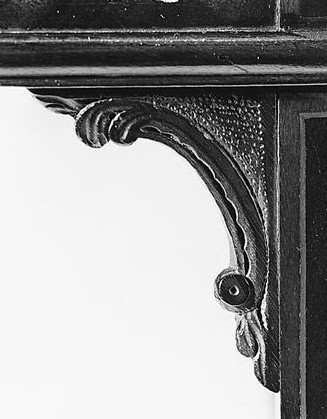
Detail of a carved bracket on the breakfast table illustrated in fig. 26. (Photo, Gavin Ashworth.)
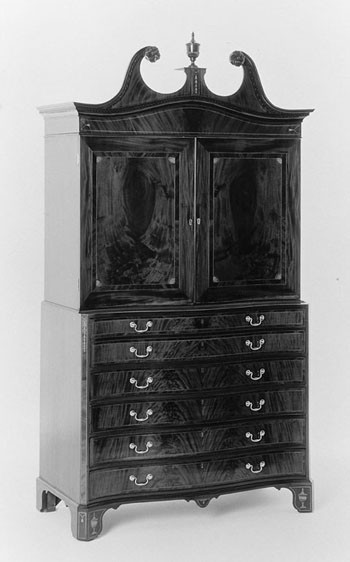
Secretary-press, Charleston, South Carolina, 1780–1790. Mahogany, mahogany veneer, and unidentified lightwood inlays with white pine, cypress, and red cedar. H. 10 5 5/8", W. 56", D. 27 3/4". (Private collection; photo, Gavin Ashworth.) The pediment was altered during the late nineteenth or early twentieth century. Although portions of the swelled frieze are original, the tympanum, scroll moldings, and rosettes are modern restorations.

Library bookcase, Charleston, South Carolina, 1790–1800. Mahogany, mahogany veneer, and unidentified lightwood inlays with red cedar, white pine, and cypress. H. 126 3/8", W. 117", D. 25". (Courtesy, Yale University Art Gallery, Mabel Brady Garvan Collection.) The broken-scroll pediment is a replacement.
